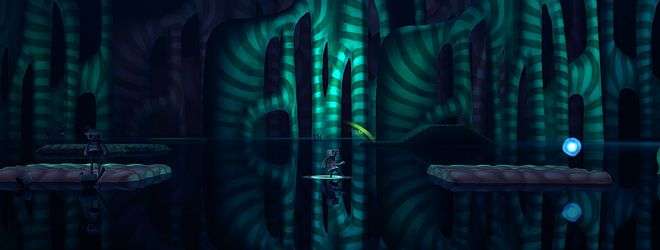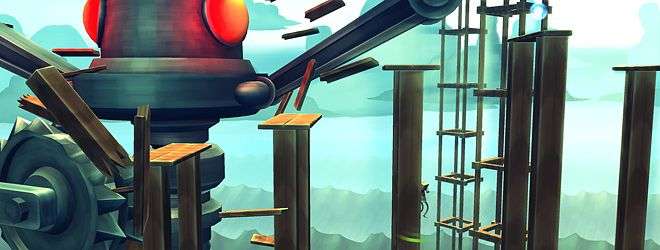OIO Review
by Mark R
|
If there’s one thing we love here at GamingLives, it’s the indie developer. Those celebrated individuals who work together to create something fantastic, without the safety net of the corporate publisher to help create the buzz, and oil the hype machine. They are the Oliver twins of the new generation of gamers, doing what they do because of a passion for the craft, typically delivering games that have that long-forgotten “one more try” aspect that reel you in and never let go.
Uncanny Games are one such studio. Founded by six students after completing their final year at the Supinfogame video game school in Valenciennes, Uncanny Games have taken some of the most important aspects of video game design and combined them to create a title which has beauty, atmosphere, purpose, and an addictive quality that keeps you coming back for more. It’s old school, with a new twist.
The story of OIO is a weary one, with our little wooden hero waking up to discover that he is the only one of his kind remaining after the rest of his people have been frozen in time. In a somewhat sombre adventure, we have to guide him to the source of this affliction and destroy it so that his people may once again breathe life to the subterranean world. The stunning visuals have a distinct hand-painted quality to them, giving everything an organic feel from the darkened corners to the brightly lit foreground, and while it doesn’t immediately scream Tim Burton and lay it on thick with the spirals and stripes, there is certainly something reminiscent to the Melancholy Death Of Oyster Boy in how fragile and simplistic everything is.

In order to traverse the world and bridge otherwise-insurmountable gaps, OIO can throw seeds at fertile areas of the world which, in turn, allows a wooden beam to grow in whatever direction the fertile area faces. The initial beam may be enough to raise OIO to a higher platform if the seed is dropped directly below, or it may be used as a starting point with which to grow additional branches to overcome environmental obstacles or hazards such as spike pits. Throwing or dropping a seed on to an existing beam will encourage a new branch to grow in whichever direction the seed lands, but with each new branch the fertility degrades, making it impossible to form another offshoot beyond a third branch, at which point all three beams become infertile.
 The right mouse button has something of a regenerative property to it, throwing out a seed which will remove whichever branch it hits and allow you to start the growth all over again. This is particularly useful for those levels where reaching a certain platform or picking up one of the various collectibles is more of a trial and error exercise whereby the realisation that you haven’t quite managed it doesn’t mean that you can’t try again with a different approach. Branches can only be stacked at right angles, however, so it’s not possible for one to grow on the end of another to create a super-length branch, and throwing a fourth seed to a new fertile area will immediately cause the existing branches to dissolve, invariably resulting in your having to quickly jump to the new branch as the originals vanish, but that serves to make for more calculated decisions.
The right mouse button has something of a regenerative property to it, throwing out a seed which will remove whichever branch it hits and allow you to start the growth all over again. This is particularly useful for those levels where reaching a certain platform or picking up one of the various collectibles is more of a trial and error exercise whereby the realisation that you haven’t quite managed it doesn’t mean that you can’t try again with a different approach. Branches can only be stacked at right angles, however, so it’s not possible for one to grow on the end of another to create a super-length branch, and throwing a fourth seed to a new fertile area will immediately cause the existing branches to dissolve, invariably resulting in your having to quickly jump to the new branch as the originals vanish, but that serves to make for more calculated decisions.
Each of the twelve levels contains a total of one hundred light orbs and three sections of what is known as the Fresk. Presumably taking its name from ‘Fresca’, each of the segments collected throughout the levels form a single length of art work which tells the tale of OIO’s people and their battle with this strange mechanical foe, but in an interpretive way rather than having it spoon fed to the player. It is this aspect of OIO that makes it something of a stand out title, wherein having no dialogue, no narrative and no cut scenes leaves everything open to interpretation based on keen observation. While certain sections may be delivered with such urgency that you don’t have much of an opportunity to soak up the surroundings, others are thankfully more tranquil and evoke a melancholic head-tilt as you walk past your kin, frozen in time. The sense of isolation, whilst still surrounded by so many, can be breathtaking at times, if somewhat disturbing.
 |
 |
 |
 |
 |
 |
With a haunting score that switches from being quiet and pensive to having something of an uplifting charm at certain areas, you’d be forgiven for thinking that Uncanny Games had managed to do what so many larger studios had failed at, and that is to create the perfect game. Unfortunately, that isn’t the case, although it could have been. The problem with OIO lies in the gameplay mechanics, and while this wouldn’t ordinarily affect the overall enjoyment of a game on any noteworthy level, the issues within OIO are such that our time with the game almost ended when we were caught in a death loop as early as level four after falling from a corroding platform, only to respawn directly under said platform and fall immediately to our death in a continuous fashion. Had this been a game with a manual save option, it may not have caused much of an issue, but with infrequent save points and an engine that didn’t recognise that the respawn point was flawed, it eventually meant returning to the start of the level… which was some thirty minutes back.
 The gameplay was further hindered by sloppy handling of the jump mechanic, often resulting in the character sliding to a halt rather than just stopping, and this also occured at the initial jump point where OIO would regularly slide forward prior to jumping and could occasionally drop off a ledge to certain death. While I understand that there’s a learning curve involved in being able to successfully control characters, especially in platformers where pixel precision is required, I also believe that this learning curve should allow us to develop a skill and not have anything left to chance over and above acquired muscle memory. All too often, even after twenty minutes of attempting particular jumps where the exact pixel had been established for the perfect jump, the character would toss an invisible coin to decide whether it would unresponsive or over-sensitive, but rarely consistent. This was never more obvious than with the final section of game, level twelve.
The gameplay was further hindered by sloppy handling of the jump mechanic, often resulting in the character sliding to a halt rather than just stopping, and this also occured at the initial jump point where OIO would regularly slide forward prior to jumping and could occasionally drop off a ledge to certain death. While I understand that there’s a learning curve involved in being able to successfully control characters, especially in platformers where pixel precision is required, I also believe that this learning curve should allow us to develop a skill and not have anything left to chance over and above acquired muscle memory. All too often, even after twenty minutes of attempting particular jumps where the exact pixel had been established for the perfect jump, the character would toss an invisible coin to decide whether it would unresponsive or over-sensitive, but rarely consistent. This was never more obvious than with the final section of game, level twelve.
Donning the critical hat for a moment, I must take issue with level twelve in its entirety because of how much of a departure it is from the rest of the game. Sure, it’s the end game and therefore has to offer more of a challenge than previous levels, but at what cost? After learning to successfully utilise the power of planting seeds to avoid various hazards, and harness the power of fire and switches to shape the environment to suit our goal, the final level ignored everything that we’d learned to this point and instead became nothing more than running the gauntlet to get from one end to the other without being caught by our antagonist. Ordinarily, this would have served as an adrenaline-fuelled frenzy with the occasional outburst as our evildoer caught up but with OIO there was no margin for error; even the slightest hesitation or attempt to correct a landing meant that you would be destroyed. After four hours and three minutes of attempting to clear a handful of platforms in order to progress, fatigue and dismay had set in and the game was left in the menu screen overnight. The next morning, after another hour of failed attempts, it was down to my partner’s perseverance to get us to the next respawn point and ultimately allow the game to be completed.
As one who has spent their gaming history playing strategy, role playing and simulations more than anything else, it may come as no surprise to find that the platformer poses a problem, but when even a seasoned platform gamer, such as my partner, complains about sloppy responses and an unforgiving amount of time in which to traverse the level, then I know it’s not just my inadequacies. Kudos to Uncanny Games though, because the one and only reason I stuck with level twelve beyond the endless hours of frustration is that I wanted to know the outcome; I wanted an end to my story. The inquisitive face of OIO, the beauty of his land, the oppression of his people… all of these combined to drive me from those first tentative steps on the first level to the point where I would set my frustrations aside for the good of the story.
 |
 |
 |
 |
 |
 |
Were it not for the attention to detail and sheer beauty of the level design, OIO may have ended up unfinished after level four. Too few indie titles gain the recognition they truly deserve, and it’s my hope that there is enough spit and polish for the gaming public to sit up and take notice of OIO and give it a chance even though there are no named voice actors, no franchises on which to hang its success and no corporate backing through which to promote the release on the side of buses or electronic billboards. This is indie development at its finest and, flawed or not, should be celebrated… and, preferably, patched!
Pros- Stunning visuals
- Some excellent environmental puzzles
- Requires creative thinking
- Story driven, but with nothing given away to the player
- Extremely well presented
- Some respawn issues
- Unnecessarily unforgiving at times
- Control mechanism could be tighter
The beauty of OIO is that it is old school platforming at its best, with just enough distance between your character and their goal to make it an excercise in pixel precision. Sadly, that is also its downfall as the mechanics aren't quite geared up for such precision and can result in losing a great deal of progress because of handling rather than skill. That said, the puzzle aspect of each level is enough to have you wanting more and does still have that "one more try" factor where the hours can very easily vanish in a sea of frustration coupled with enjoyment.
Respawn issues aside, as all games are known to glitch from time to time, had there been more margin for error in the final level and if it had used more of the acquired abilities from previous levels, then OIO would have walked away with an easy 9/10 score... because it's beautiful, haunting, excellently presented, and allows the player to interpret the story in their own way. Unfortunately, the unforgiving nature of the finale on such a short level that has barely any imagination means that it has been scored down.
As frustrating as those final hours wrestling with the final level were, OIO is still a great game, and comes highly recommended to those with a great deal of patience, a lot of time to kill, and a swear box.
Last five articles by Mark R
- From Acorns to Fish
- Alone In The Dark
- Why Borderlands is Better Than Borderlands 2
- Falling Short
- The Division: A Guide to Surviving the Dark Zone Solo























Honestly? This game sounds fantastic, if a bit more frustrating than I’d expect it to be.
I hope they do well though, love seeing Indie games getting more exposure
This game looks stunning and very reminiscent of Tim Burton, with the sinister style visuals. At times it almost seems melancholy in a way and I found the frozen things in the background almost disturbing and sad as I watched you play. I have to say, however, for a platformer it was especially brutal… that section at what was almost the end of the game was ridiculously hard – precision jumping taken to grotesque extremes, which is a shame as it may well ruin the game at that point for those who can’t get past it and who may then give up. The game deserves to be completed, so a tiny bit of slack could have been cut here.
Still, the concept was a great one and the execution looked fantastic from what I saw of you playing. Indie games at their very best.